Industry Outlook -- Rough terrain mechanical elevated work platforms
Rough-terrain aerial lifts get a facelift.
It’s been an interesting year in the aerial work platform industry. The long-awaited ANSI standard updates are set to take effect December 10, 2019, and with that comes new requirements that affect the complete chain of manufacturers, dealers and rental centers and end users. Th enew regulations have even spawned a new name for areial work platforms; they’re now known as Mechanical Elevated Work Platforms, or MEWP for short.
Pro Contractor Rentals magazine asked industry professionals for their insight about trends with rough-terrain MEWPs, and how the changing ANSI standards are changing the face of the industry. They also comment on wheeled vs. tracked units and their fit in the market.
 |
|
Lenny Polonski |
Demand for nimble units
The new generation of contractors are much more savvy and demanding. They are demanding equipment that has much versatility and capable of doing many jobs, more portable and cost less.
Spider-style or compact lifts offer much more versatility than the old heavy, slow and cumbersome boom lifts that need tractor trailers to move between worksites. Spider-style lifts with up to 100-foot reach can be easily towed to a job site with ¾ ton pick up truck. Some can even self-load/unload from a truck chassis such as a F550 or Isuzu cab-over truck, allowing use directly from the truck chassis as a truck mount lift or, simply place outriggers down on the ground, drive the truck from under the lift, lower the lift onto the ground then drive through a 36-inch gate or door.
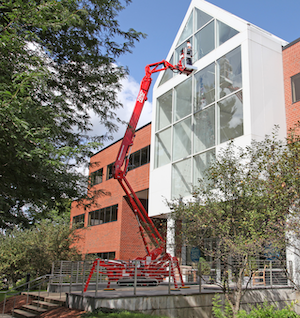 |
| Spider-style or compact lifts offer much more versatility than the old heavy, slow and cumbersome boom lifts that need tractor trailers to move between worksites. |
Tracks have the advantage of much lower ground pressure can better handle steep slopes, mud and snow. However, they can tear up a lawn if the operator makes sharp turns. Conversely, wheels can travel long distances faster and can roll over curbs.
There is a new training responsibility requirement becoming effective this fall that everyone needs to be aware. No longer can you simply hand the keys over to anyone walking in the door.
 |
| Sean Larin Genie Product Manager Terex AWP |
New models require versatility
Strong growth in new build construction is leading contractors and builders to seek out more versatile boom lifts, capable of working across the full range of rough-terrain job sites. The aerial market is responding with the new machines designed to operate on a wide variety of surfaces and complete jobs more quickly through increased lifting capacity.
Here’s an example: At the 80-foot height class, boom operators can choose between the Genie Xtra Capacity (XC) or High Float (HF) models, depending on the needs of the job. The Genie S-85 XC model can drive through rough, muddy jobsites with foam-filled rough-terrain tires and positive-traction four-wheel drive, all while providing the boom operator with 1,000-/660-pound dual platform capacity.
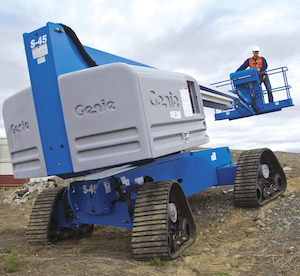 |
| When a job requires working on extreme surfaces such as soft snow, loose gravel, wet mud or generally soft underfoot conditions, Genie TraX machines with a Genie four-point TraX track drive system can allow job access. |
When job site surfaces are sensitive turf or ultra-fine sand, the Genie S-85 HF boom and its air-filled 41/18LL x 22.5 20 ply tires help it to “float” on and protect softer surfaces that could be damaged by the more aggressive tread of regular rough-terrain tires. Even with the high floatation tires, the Genie S-85 HF boom still provides operators with heavy duty 1,000/600-pound dual platform capacity.
When a job requires working on extreme surfaces such as soft snow, loose gravel, wet mud or generally soft underfoot conditions, Genie TraX machines with a Genie four-point TraX track drive system can allow job access. Genie TraX systems are available on Genie telescopic booms at heights ranging from 40 to 65 feet.
On a typical new job site, a wheeled rough-terrain boom lifts will be the versatile workhorse from the start of the job to the end. If equipped with non-marking rough-terrain tires, the machine can even be used on finished slab near the end of the job often when rubber marks and scuffs are not acceptable. The addition of positive-traction four-wheel drive, four-wheel steering and active oscillating axles helps a wheeled rough terrain boom move across an entire job site in many conditions.
Boom lifts equipped with track drive systems, especially when the system fetures four independent tracks, have an increased ability to overcome soft, uneven, or unsettled surfaces. These machines are put to work on job sites ranging from the sugar sands of Florida to the snow-covered tundra of the Canadian oil fields. Tracked machined are often viewed as the definition of rough terrain.
There are significant changes coming to both equipment and the requirements that operators, job sites, and rental centers must follow. All mobile elevating work platforms (MEWPs) will be required to have platform load sense systems that continuously check the weight in the platform and disable operation if the load is above the platform load limit. Equipment will also be required to disable certain drive and lift functions when out of their slope limit. Additional equipment changes include reduced lift and lower speeds, required toe guards on entrances and prohibited use of flexible and chain gate entries.
It’s important to note that the updated ANSI A92 standards will not require retroactive changes, so existing fleets are not affected. Also, the new standards will make sweeping changes to how safe use and training for MEWPs are addressed and administered. Major changes to be aware of include safe use planning, supervisor training, occupant training, maintenance and repair personnel training, as well as the creation/use of risk assessment plans.
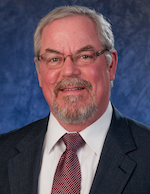 |
| Bill Dovey Senior Product Manager JLG Industries, Inc. |
Higher capacity, more training required by end users
In the rough terrain scissor lift category, customers are increasingly demanding high-capacity rough-terrain scissor lifts capable of carrying more employees, equipment and tools on the platform to the work site. In addition to their ability to support larger loads, JLG’s LRT series scissor lifts offer excellent gradeability and maneuverability on rough terrain. These types of scissors typically offer tow to three times the capacity and three to five times the platform space of boom lifts.
Environmental awareness is of increasing importance to users, so JLG’s compact crawler booms offer an innovative green Li-ion battery option for quiet, clean, zero-emissions operation, which is - great for indoor and outdoor environments. End-users also appreciate lighter and more sustainable products, accomplished through means such as better fuel efficiency.
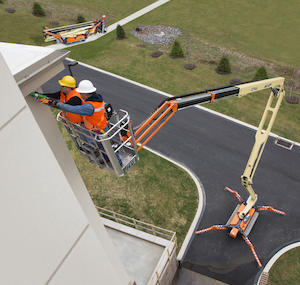 |
| JLG’s X770AJ compact crawler boom features a narrow chassis and a unique narrow outrigger setting, making it easier to fit through doorways and gates. Transporting the boom is also easier, thanks to forklift pockets and dedicated lift hooks. |
End-users and operators are also seeking increased versatility while owners are seeking a lower total cost of ownership. For example, JLG’s X770AJ compact crawler boom features a narrow chassis and a unique narrow outrigger setting, making it easier to fit through doorways and gates. Transporting the boom is also easier, thanks to forklift pockets and dedicated lift hooks. The X770AJ is designed for a lower total cost of ownership with hoods that open wide, making service access easier and a LCD panel that communicates in text – rather than fault codes – for faster troubleshooting and reduced need for on-site service calls.
Rental centers should seek training from their manufacturer or obtain copies of the new ANSI standards due to training requirements of mechanics, site supervisors, operators and even occupants in the platform. It’s imperative to understand these safety standards, stay abreast of any upcoming modifications and prepare accordingly. The new ANSI A92 standard addresses new issues, simplifies the MEWP classification terminology and promotes safety and education.
When it comes to safe use and training, machine owners and operators will have their own sets of responsibilities with which to comply. Dealers and rental companies will need to update their training procedures and onboarding manuals to support new requirements and train employees on new machine features and the new standards. They must also offer familiarization to customers who rent, lease or buy this equipment. Owners and operators must meet all new training requirements, participate in extensive planning to consider machine choice and application and perform site risk assessments for all MEWP operations and training procedures.
Anyone qualified under current standards will not be qualified under the new standards until they undergo additional training. While current regulations require all operators in the industry to go through safety training, the new standards will require everyone who supervises MEWP operators to also be trained and possess in-depth knowledge of the equipment. Examples of the knowledge required by occupants includes being well-informed about hazards associated with MEWPs, unsafe ground conditions or electrical hazards, and how to properly lower the machine in case something happens to the operator.
 |
|
Michael Sover |
Users want more capacity, work area
Many companies are adopting innovative technologies, such as telematics and smart hydraulics. Manitou’s telematics product offering is called Easy Manager and is a standard feature on the majority of our product lines.
Easy Manager is a web portal and mobile app that gives actionable data at customer’s fingertips to help with the day-to-day management of their operations. It makes preventive maintenance, machine security, increasing uptime and customer service easy, all of which allows the customer to concentrate on its core business and allows machine owners to manage the life cycle of each machine.
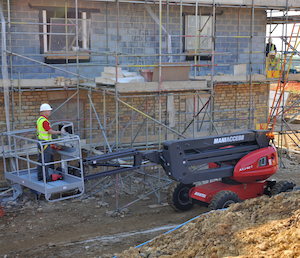 |
| The Manitou ATJ 46+ is a 46-foot articulated telescopic jib boom that offers an industry-leading unrestricted platform capacity of 900 pounds. It also features an extra-large working area within the platform designed to hold three people comfortably with a 7-foot, 7-inch length and 3-foot width. |
Manufacturers are focused on improving the efficiency and productivity of machines and reducing the total cost of ownership. In order to lower the total cost of ownership (TCO), Manitou offers a Stop and Go system on the ATJ 46 model that allows the engine to run only when the machine is actually working, which lowers fuel consumption, reduces wear and tear and can result in better resale value.
Based on end-user feedback, manufacturers are moving toward increased platform capacity and work space in the platform. Currently Manitou has the ATJ 46+, a 46-foot articulated telescopic jib boom that offers an industry-leading unrestricted platform capacity of 900 pounds. It also features an extra-large working area within the platform designed to hold three people comfortably with a 7-foot, 7-inch length and 3-foot width.
Most rental companies and end users will accept the new ANSI A92 rules with no major issues. The industry has been aware of these changes to the ANSI standard for over a year and most rental companies have been planning for this change and have been updating their training programs and educating their employees and customers on the upcoming changes.
The new standard will apply to anyone who operates, supervises or maintains MEWPs. While ANSI standard compliance is voluntary, OSHA usually adopts the ANSI standards and they they become incorporated as part of the OSHA regulation. Compliance with the OSHA standards is mandatory, therefore failure to follow any ANSI standards that has been adopted by OSHA would be considered a violation of OSHA’s requirements for job site safety.
The ANSI A92 standard also calls for more platform operators training. Operators won’t be allowed to get on a machine unless they’ve had additional training on it. Operators and supervisors will have to undergo training to better understand the machines’ operation. Some of the training will include becoming familiar with the new features of the machine, learn about proper MEWP selection, applicable rules and regulations, potential hazards associated with the MEWP’s use, and be knowledgeable about the manufacturer’s operation manuals. Occupants in MEWPs will also require additional training under the new A92 standard.
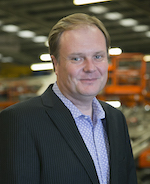 |
| Matthew Elvin CEO Snorkel |
Push for alternative power sources
One of the major continuing trends in rough terrain aerial work platforms is the demand for alternate power sources to diesel engines. Driven largely by increasing regulations on reducing emissions and noise pollution, there has definitely been an increase in demand for both hybrid and full electric solutions that still deliver rough terrain performance.
Just as we have seen in the automotive industry, the construction equipment industry is now exploring alternative fuel options that are able to replicate or exceed the performance and duty cycles of the diesel-powered versions.
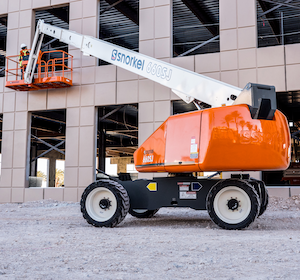 |
|
Snorkel is currently developing a four-track option for its 660SJ telescopic boom lift. |
Snorkel offers all of its rough-terrain scissor lifts as diesel powered, bi-energy powered units that enables the operator to switch between the gas or diesel engine, and 100 percent battery power. Equipped with four-wheel drive and high-grip, non-marking tires, these bi-energy compact rough terrain scissor lifts comply with emissions and noise regulations and provide flexibility to work indoors and outdoors with the same machine.
At Bauma 2019, Snorkel previewed a full-electric, Li-ion battery powered SL26E Speed Level, which is a rough terrain sigma boom that can self-level and be driven at full height on gradients up to 50 percent. The new SL26E is due to enter production in late 2019, and Snorkel is planning to utilize this Li-ion technology in other existing models, such as rough terrain scissor lifts, for introduction by mid-2020.
Tracked vehicles have their advantages. They are often available with two tracks, one on each side, or four independent tracks that are located at the same location as a wheel. Two-track aerial lift designs have to deal with the break-over angle when negotiating a ramp or sloped surface and this can surprise an operator if they are unfamiliar with the operating characteristics of these type of machines. These types of systems use a skid steer design in place of a traditional steering mechanism found in four track or typical wheeled systems.
Four-track systems are much more similar in operation to a traditional wheeled machine but create much less compaction under the tracks when compared with tires. They offer much better flotation and improved tractive effort in all types of soft surfaces. The cost and maneuverability due to reduced steering angle are some drawbacks of most track systems.
Snorkel is currently developing a four-track option for its 660SJ telescopic boom lift.
The implementation of platform load-sensing systems is a major change that the new ANSI A.92 standards will bring. Platform load sensing will be required on almost all mobile elevating work platforms (MEWPs), which is the new terminology for aerial work platforms (AWPs).
The platform load sensing systems will alert operators as they approach the rated capacity of the lift and will prevent certain movements when exceeding rated capacity. With rough-terrain scissor lifts, new models that comply with the new ANSI standards may weigh more and have fewer flotation tire options.
Snorkel has already made foam-filled tires standard across most of its rough terrain scissor and boom lift product lines. All rough-terrain models will be fitted with foam-filled tires when ANSI A.92 becomes effective.
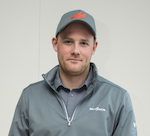 |
| Kristopher Schmidt Product Manager Skyjack |
Wheeled vs. tracked units
The 30- to 35-foot class scissor lifts show the strongest continued demand with 50-foot and higher models following closely after. The industry will also start seeing modifications on production of existing models from manufacturers across the board as they prepare for new ANSI standards. Stability testing requirements and load sensing are key changes users start seeing on-site as a result of the new design standard.
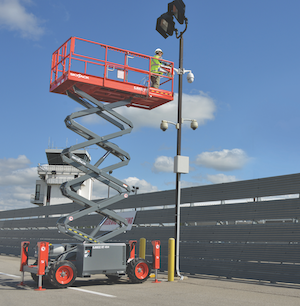 |
| The 30- to 35-foot class scissor lifts show the strongest continued demand with 50-foot and higher models following closely after. |
Wheeled rough-terrain scissor lifts have always been the preferred configuration over tracked units. Due to the great availability and sourcing of tires, lower initial purchase cost, replacement costs, and little to no maintenance requirements. However, tracked rough-terrain units can climb steeper grades and don’t get stuck in some of the applications where a normal tire might have difficulty. The initial cost of tracked MEWPs is very high and they require more maintenance than wheeled units.
As the market adapts to the new ANSI standards, there are a number of educational materials available to help rental companies educate themselves and their customers. The educational materials go over the core changes of the ANSI standards including new design features like load sensing and training changes like the fact that operators and occupants now have to be trained. Skyjack is one source for this resource material and a dedicated webpage, www.skyjack.com/new-ansi, specifically addresses these new standards and the changes rental companies and end users can expect to see. Visitors to that page are able to download resource material such as posters, rack cards and white papers to share with their audiences.
This article appeared in the September-October 2019 issue of Pro Contractor Rentals magazine. © 2019 Urbain Communications LLC. All rights reserved.








